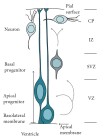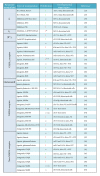Bioelectric state and cell cycle control of Mammalian neural stem cells
- PMID: 23024660
- PMCID: PMC3447385
- DOI: 10.1155/2012/816049
Bioelectric state and cell cycle control of Mammalian neural stem cells
Abstract
The concerted action of ion channels and pumps establishing a resting membrane potential has been most thoroughly studied in the context of excitable cells, most notably neurons, but emerging evidences indicate that they are also involved in controlling proliferation and differentiation of nonexcitable somatic stem cells. The importance of understanding stem cell contribution to tissue formation during embryonic development, adult homeostasis, and regeneration in disease has prompted many groups to study and manipulate the membrane potential of stem cells in a variety of systems. In this paper we aimed at summarizing the current knowledge on the role of ion channels and pumps in the context of mammalian corticogenesis with particular emphasis on their contribution to the switch of neural stem cells from proliferation to differentiation and generation of more committed progenitors and neurons, whose lineage during brain development has been recently elucidated.
Figures


References
-
- Levin M. Large-scale biophysics: ion flows and regeneration. Trends in Cell Biology. 2007;17(6):261–270. - PubMed
-
- Robinson KR, Messerli MA. Left/right, up/down: the role of endogenous electrical fields as directional signals in development, repair and invasion. BioEssays. 2003;25(8):759–766. - PubMed
-
- Zhao M. Electrical fields in wound healing—an overriding signal that directs cell migration. Seminars in Cell and Developmental Biology. 2009;20(6):674–682. - PubMed
-
- McCaig CD, Rajnicek AM, Song B, Zhao M. Controlling cell behavior electrically: current views and future potential. Physiological Reviews. 2005;85(3):943–978. - PubMed
-
- Funk RHW, Monsees TK. Effects of electromagnetic fields on cells: physiological and therapeutical approaches and molecular mechanisms of interaction. A review. Cells Tissues Organs. 2006;182(2):59–78. - PubMed
LinkOut - more resources
Full Text Sources

